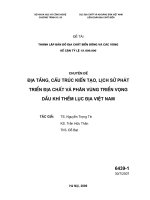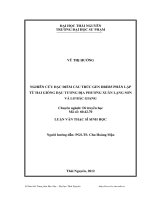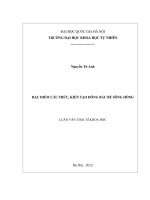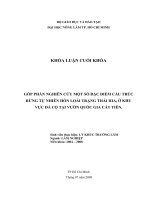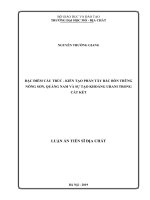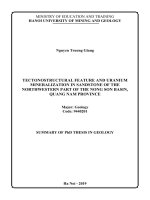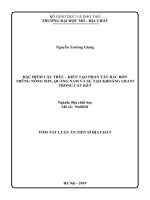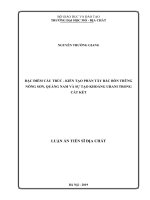Đặc điểm cấu trúc kiến tạo phần tây bắc bồn trũng nông sơn, quảng nam và sự tạo khoáng urani trong cát kết tt tiếng anh
Bạn đang xem bản rút gọn của tài liệu. Xem và tải ngay bản đầy đủ của tài liệu tại đây (742.01 KB, 31 trang )
MINISTRY OF EDUCATION AND TRAINING
HANOI UNIVERSITY OF MINING AND GEOLOGY
Nguyen Truong Giang
TECTONOSTRUCTURAL FEATURE AND URANIUM
MINERALIZATION IN SANDSTONE OF THE
NORTHWESTERN PART OF THE NONG SON BASIN,
QUANG NAM PROVINCE
Major: Geology
Code: 9440201
SUMMARY OF PhD THESIS IN GEOLOGY
Ha Noi - 2019
The thesis is completed at:
The Department of Geology, Ha Noi University of Mining and Geology
Supervisors::
1. Prof. Tran Thanh Hai, PhD
2. Assoc. Prof. Nguyen Phuong, PhD
Reviewer 1: Prof.DSc. Dang Van Bat
Reviewer 2: PhD. Nguyen Van Nguyen
Reviewer 3: PhD. Vu Quang Lan
The Thesis has been evaluated by the Assessment Council for
Doctoral Thesis under the University Level at……., ….. ….. 2019 at
the Ha Noi University of Mining and Geology
The thesis can be found at: - The National Library of Vietnam
- Ha Noi University of Mining and Geology
1
INTRODUCTION
1. The necessity of research
Vietnam is a country with high uranium potential, in which the
sandstone - hosted uranium mineralization type in the Nong Son Basin is
supposed to have the greatest potential and appropriate conditions for
mining. The sandstone-hosted uranium deposits and mineralizations are
considered as important material input for development of the atomic
energy sector. The geological mapping and mineral survey at 1:200 000
and 1:50 000 scales have been implemented for The Nong Son Basin in
general, the northwest area of the basin in particular; some of uranium
potential areas have been investigated and evaluated at 1:10 000, 1:5 000
and 1:2 000 scales. In addition, many scientific research projects on
uranium minerals have been carried out by different geoscientists since
1975 to present days.
The above mentioned studies have addressed the problems at the
various levels in terms of geology, tectonics uranium mineralization
controlling contexts and the potential of uranium resources in the prospect
areas. The obtained results are important fundamentals to orient
subsequent researches. However, most of the research works only focussed
on general distribution pattern of the uranium ores, lithological
characteristics, ore composition, mineral content, and geochemistry, etc.
To date, no detail study on tectonics- structure and its linkage to the
uranium mineralization has been implemented. The interpretation on
tectonics-structure, establishing deformation phases and reconsruction of
geological history of the Nong Son Basin in general, and in the
northwestern portion of this basin area in particular as well as the linkage
to the uranium mineralization in accordance with principles of the Plate
tectonics theory are necessary tasks in order to meet the practical demands.
These are important in delineation of the distribution pattern of the
mineralization zone, the level of concentration, morphology of ore bodies
in each area. With such outcomes, the zoning of prospect areas and planing
for surveying, evaluation and exploration on uranium within the
investigated areas will be carried out effectively thereby.
In order to resolve the above-mentioned demands a thesis entitled:
“Tectonostructural feature and uranium mineralization in sandstone in the
northwestern part of Nong Son Basin, Quang Nam Province " was
proposed for this study.
2
2. Objectives of the research
To define characteristics of tectonic - structural setting in the Northwest
of the Nong Son Basin as well as its controls on uranium mineralization in
sandstone in order to provide database for the orientation of subsequent
investigation, evaluation and exploration programs.
3. Object and locality of the research
- Object: Geological units, geological structure and uranium
mineralization in sandstone.
- Locality: Northwestern area of the Nong Son Basin, Quang Nam
Province and surrounding regions.
4. Major tasks of the research
- Defining composition, pattern and age of major geological units as
well as characteristics of uranium mineralization in northwestern portion
of Nong Son Basin.
- Studying tectonics - structures of the northwestern portion of Nong
Son Basin and and interpreting the constraint of the tectonic structures on
uranium mineralization in sandstone of the study area.
- Establishing scientific and practical basis to orient surveying,
evaluation and exploration programs for uranium in the northwestern
portion Nong Son Basin.
5. Scientific and practical implication of the project
5.1. Scientific implication
- The new data on geological structure, age and forming conditions of
geological units and uranium mineralization presented in the thesis are
impotant contributions to geological database of Vietnam.
- The reconstruction of geological history of the Nong Son Basin and
the role of tectonic deformation for uranium mineralization are new
findings that useful for the interpretiation of origin, distribution model,
morphology of uranuium ore bodies in the study area in particular and the
Nong Son Basin in general.
5.2. Practical implication
- The establishment deformation phases, reconstruction of geological
evolution of the northwestern part Nong Son Basin in particular and the
Nong Son Basin in general as well as their controls on uranium
3
mineralization in sandstone provided practical contributions in planing of
surveying, evaluation and exploration works in the Nong Son Basin.
- The establishment of premises, indicators and delineation of potential
areas for uranium mineralization in sandstone within the study area are
considered important scientific basis in proposing subsequent surveying,
evaluation and exploration activities in potential areas of the northwestern
part of Nong Son Basin.
6. Theoretical point of view
- View point 1: The northwestern part of Nong Son Basin has
experienced complex tectonic deformations, in which the Middle Triassic Jurassic sedimentary rocks unconformably overlying the deformed preMesozoic basement rocks have been strongly affected by 4 deformation
phases. The post-deposition tectonostructural elements are important
controls on uranium mineralization in sandstone of the study area.
- View point 2: The uranium mineralization in the study area has been
formed in 4 different periods, which spanned from ~144 to 14 Ma. The
uranium mineralization has initially been produced by the redox
mechanism and accummulated along the redox front formed by the
interection of oxidating fluid and reduction elements within the coarsegrained clastic sedimentary rocks of the An Diem Formation. The
continuous impacts of subsequent deformational events have led to
reworking of previously formed mineralization and deposting secondary
mineralizations at various ages.
7. New findings of the thesis
- The study results have identified the nature of various structures,
establish and classify deformation phases, reconstruct tectonic evolution of
the northwest part Nong Son Basin as well as to interpret linkage of
uranium mineralization to the tectonics - structure of the study area. The
northwest part of Nong Son Basin has been strongly affected by 5
deformation phases, in which the 1st phase affected the pre-Mesozoic
basement rocks while other 4 deformation phases have modified all rocks,
including the Mesozoic sedimentary formations.
- The new results have contributed to the identification of the linkage
between the rock deformation and uranium mineralization, suggesting that
post-deposition deformations have controlled uranium mineralization in
the Northwest Nong Son Basin.
- The uranium mineralization occurs in coarse-grained clastic
sedimentary rocks, which have been deposited and reworked in 4 periods
4
spanning from ca. 144 to 14 Ma. Uranium has been accumulated in the
rock as the result of post-deposition redox processes, in which ore was
deposited along along the redox front as the the mixing of oxidation fluid
and reduction elements. Mineralized zones were produced, remobilized,
altered and redeposited in a complex pattern due to continual impacts of
the multiphase regional deformation.
- The results have provided premises and indicators for surveying and
delineating potential areas of uranium mineralization at various levels
within the northwestern portion of Nong Son Basin. These are important
scientific basis for surveying, evaluation and exploration of the uranium
ore in the study area.
8. Structure of the thesis
In addition to the preface and conclusion part, this thesis contains four
chapters:
Chapter 1. Overview of the northwestern part of Nong Son Basin
Chapter 2. Basic principles and research methodology
Chapter 3. Geological setting and uranium mineralization of the
northwestern part of Nong Son Basin
Chapter 4. Tectonostructural feature and its role for uranium
mineralization in the northwestern part of Nong Son Basin
9. Database for the thesis
The thesis was completed based on documents directly collected,
processed and interpreted by the candidate during carrying outscience
researches and geological surveying at the Geological Division for
Radioative and Rare Elements. Especially, field data and sample analytical
results gathered since 2010, including:
- Gelological mapping and mineral survey reports at different scales
available for the study area, especially field investigation data on
geological structure and sampling analysis clollected and processed by the
candidate.
- Updated data on field investigation, geological mapping, tectonicsstructure studies in the northwestern part of Nong Son Basin completed by
candidate during this thesis preparation.
- New data on thousands of samples analysed for uranium chemical
contents, hundreds of thin section and ICP-MS, and organic carbon
analyses, suppoted by the Uranium exploration project in Pa Rong- Pa Lua
area that is hosted by to Geological Division for Radioative and Rare
Elements. Especially the analytical results of 7 convential U-Pb dating
5
samples to determine absolute age of magmatic rocks; 2 samples to
determine provenance age of the sedimentary rocks used SHRIMP and
LA-ICP-MS methods; 1 sample analysed absolute age of uranium ore have
been ontained by the candidate during the thesis preparation.
- The published materials consisting of thematic material, scientific
reports, articles related to study area; the documents obtained from
prospecting, geological baseline surveying works, evaluation and
exploration programs carried out by Geological Division for Radioative
and Rare Elements within and surrounding the study area. In addition, the
candidate also collected other scientific research papers, books, journals on
uranium mineralization from domestics and foreign providers.
10. Traininng Institution
The thesis was completed at the Department of Geology, Faculty of
Geoscience and Geoengineering, Hanoi University of Mining and
Geology.
11. Acknowledgment
The candidate would like to gratefully thank to Prof. Dr. Tran Thanh
Hai and Assoc. Prof. Dr. Nguyen Phuong, who have enlightened and
supervied the candidate throughout researching process as well as their
unconditional support completing this thesis. I would like to acknowledge
the Department of Geology, Faculty of Geoscience and Geoengineering,
Department of Postgraduate Training, Directory Board of Hanoi
University of Mining and Geology in providing generous support for the
candidate to complete the thesis.
I also would like to send my sincere thanks to the scientists of the
Department of Geology and Mineral of Vietnam, Geological Assocciation
of Vietnam, Institute of Geosciences and Mineral Resources of Vietnam,
Geological Institute of the Academy of Science and Technology of
Vietnam, Russian Geological Institute(VSEGEI), the Institute of
Geosciences and Mineral Resources of Korea (KIGAM), Rare Trace
Elements Laboratory (Laboratory of Critical Elements) of the University
of Science and Technology AGH of Poland, Radioactive and Isotope
Laboratory of the Institute of Geology-Geophysics of the Chinese
Academy of Sciences., and all colleagues in Geological Division for
Radioative and Rare Elements, for they generous supporting in analyzing
of the high-quality samples as well as created favorable working
environment for the completion of this thesis.
6
Chapter 1. OVERVIEW OF THE NORTHWESTERN PART OF
NONG SON BASIN
Location and geological setting of the research area
The northwestern part of Nong Son Basin is situated in the Dai Loc,
Nam Giang and Tay Giang districts, Quang Nam Province, which extends
over ~1000 km2.
1.1.1. Tectonic position of the study area
Tran Van Tri and Vu Khuc et al. (2009) proposed that the study area
belonging to an intracontinental rift system, which occurred after the
Mesozoic Song Bung - An Khe collision and overlies the Early - Middle
Paleozoic Quang Da Orogenic Belt and the pre-Cambrian Kon Tum
Massif; it is a complex structure, which was formed during the Paleozoic
orogeny and was subsequently deformed in Mesozoic. Tran Thanh Hai et
al. (2014) reckoned the northwestern part of Nong Son Basin has been
resulted from an extensional process following a post-Indochina-Sibumasu
collision event.
1.1.2. Geological setting of the study area
1.1.2.1. Geology of the Nong Son Basin
a. Metasedimentary and sedimentary units
Pre-Cambrian units: Consist of sedimentary and vo,lcanic rocks, which
have been metamorphosed to amphibolitic facies of the Kham Duc - Nui
Vu complex (NP3-Є1kv).
Early Paleozoic sedimentary units: Comprise mainly terrigenous
sedimentary, carbonatic-terrigenous, carbonate and shaly sequences, which
are intercalated by intermediate - acid volcanic rocks and theirtuffs, which
are grouped to of the A Vuong Formation (Є2-O1 av). The rocks have been
metamorphosed to green-schist facies.
Mesozoic sedimentary and volcanic units: extensively filled and
exposed in the Nong Son Basin which includea number of formation such
as Song Bung (T2sb), An Diem (T3nađ), Suon Giua (T3n-r sg), Ban Co
(J1bc), Khe Ren (J1-2kr) and Huu Chanh (J2hc).
Cenozoic sedimentary and volcanic units: Include Neogene
sedimentary rocks overlain by the Quaternary unconsolidated sediments
(Q).
7
b. Intrusive rocks
Early-middle Paleozoic intrusive rocks: most are granitic rocks that
extensively observed in the northern margin of the study area. They are
exposed as batholiths and/or minor dykes, which comprise part of the Dai
Loc Complex (γaD1đl).
Late Paleozoic - Mesozoicintrusive rocks: this formation was observed
along the southern margin of the Nong Son Basin, it is characterized by
diverse composition, mostly vary from intermediate to acidic rocks. The
rocks were sub-divided into the Ben Giang - Que Son (γδP2-3 bq), Chaval
(aT3 cv), Hai Van (γaT3hv) and the Ba Na (γK-Ebn) Complexes.
1.1.2.2. General tectonic deformation of the Nong Son Basin
The strong and superposed tectonic deformations have led to significant
change in the order, attitude, continuity and geological relationship of the
rocks. The pre-Mesozoic units have been entirely disturbed. The subsequent
superposing tectonic activities have transformed and modified the older
structures, creating complicated regional structural interference pattern s.
Development of the geological formations and deformational events in Nong
Son Basin all have been associated with evolution of the continental crust
due to the continuous convergence and collision of tectonic plates into the
margin of the Indochina Block in the Phanerozoic.
Previous studies on geology and uranium mineralization of the
study area
1.2.1. Before 1975
Mainly are regional geological mapping and mineral discoveries
achieved by both French and Vietnamese geologists.
1.2.2. After 1975
The regional geological survey and uranium studies were only
conducted after 1975, mostly after 1980 once several uranium occurrences
were discovered in the Nong Son Coal Mine, especially uranium
mineralizations in sandstone of the Nong Son Basin was discovered. Many
projects on geological survey and uranium potential evaluation have been
conducted.
Regarding researches on uranium mineralization, there have been
several scientific studies on origin of the uranium ore formation,
depositional environment as well as the source of uranium ore in Nong
Son Basin (Trinh Xuan Ben, 1995), or classification and relating of
8
uranium mineralization types to the classic deposit model in the world
(Nguyen Quang Hung, 2002).
Exisiting problems in the previous studies
The previous studies on uranium have only focused on uranium
potential in saperate areasand porposed orientation for porspecting and
exploration works. The researches on geological setting, tectonicstructure, uranium mineralization, petrology, facies geochemistry,
depositional environment, etc. In the Nong Son Basin have only been
carryied out at larger scale of a regional geological context, lack of detail
data and quantitative studies. Characteristics of deformation, evolutionary
history of the Northwestern Nong Son Basin and their linkage to the
uranium mineralization in sandstone have been addressed in some
scientific documment, but they demonstrated limitedr data. The study on
uranium mineralization in sandstone just has only been implemented in
terms of depositional mechanisms while other controlling elements such as
age of uranium ore formation, tectonic regimeduring the sedimentary
deposition, uranium mineralization, accumulation rule and uranium
distribution pattern in each period of sedimentation have not been well
defined.
The above mentioned existence need to be well defined. The study on
tectono-structure and reconstruction of evolutionary history of the
northwestern part of Nong Son Basin will contribute to interpretation of
ore forming mechanism, distribution of the uranium ore bodies in the study
area. This is one of the proper approaches in solving the problem of origin,
ore forming conditions and distribution rule of the uranium ore in the study
area.
Chapter 2. BASIC PRINCIPLES AND RESEARCH
METHODOLOGY
2.1. Basic principles of uranium mineralization in sandstone
2.1.1. Uranium deposit models in sandstone
2.1.1.1. Overview of uranium deposits in sandstone
Uranium deposits in sandstone are uranium accumulation, which are
largely resulted from oxidation-reduction (redox) process occurring in
sandstone units of the molasse lacustrine and fluvial formations. The
uranium deposits in sandstone are often formed at the margin of the basin
and are accumulated in the coarse grained rocks such as sandstone, coal-
9
bearing sediments, peat. Uranium accumulation is usually associated with
vanadium, copper, selenium and other elements.
a. Morphology of ore bodies
Uranium ore bodies in sandstone are diversified in morphology, often
in lenticular, lenticular-tabular or pocket forms, whose thickness varies
from a few tens of centimetre to 20-30 m. Redistribution of uranium inside
reservoir is controlled by distance and direction of water flow, as well as
by surrounding environment and controlling structure. These are major
factors controlling various shape and size ore bodies.
b. Genesis of uranium in sandstone
The recent study results led to two basic hypotheses of the uranium
migration and accumulation oin sanstone, as follows:
- Firstly, uranium is a syngenetic product during sedimentation.
- Secondly, uranium accumulates due to the process of infiltration and
migration of meteoritic water through the rocks, triggering oxidization of
sedimentary minerals and dissolving uranium compounds and hence
released uranium, which was subsequently migrated to and accumulated in
more comfortable areas (e.g., the redox environment).
2.1.1.2. Classification of uranium deposits in sandstone
Dahlkamp (2009) classified uranium deposits in sandstone into 4 subtypes as follow (Figure 2.1):
+ Sub- type 1: Roll - front deposits.
+ Sub- type 2: Tabular deposits.
+ Sub- type 3: Basal channel deposits.
+ Sub- type 4: Tectonic/lithological deposits.
Figure. 2.1. Sub- types of uranium deposits
10
2.1.2. Elements controlling uranium mineralization in sandstone
2.1.2.1. Tectonostructure
The regional and local tectonostructures play different roles for the
uranium mineralization, but in generally both types provided comfortable
environment for the migration/circulation of oxidating fluid, dissolving of
uranium,
ccumulation
and/or
destroying/redistribution
and
complicatizating uranium ore bodies.
2.1.2.2. Lithology and rock facies
Petrological composition and physical characteristics of sedimentary
rocks are one of the most important factors controlling the mingration of
ore-bearing fluid and accumulation of uranium deposit in sandstone by the
oxidation-reduction (redox) mechanism.
2.1.2.3. Geochemistry
For uranium mineralization, the oxidation zoning of fluid reservoir is
important for ore forming process. The uranium mineralization zone is
corresponding to reduction barrier, characterizes rapid change in
oxidation-reduction potential and content of different components
dissolved in water and rocks.
2.1.2.4. Hydrogeology
The uplifted areas are considered as the groundwater recevoirs, which
supply meteoritic, oxidited water to the basin. The present models on
uranium deposit in sandstone confirm the participation of oxidating water
and its downdip migration along the margin of artesian aquifers.
2.1.2.5. Paleo-climate
The climate also is an important element for uranium deposit formation
in sandstone. Recent studies all shows that this model is mostly distributed
in tropical region, less in temperate region and entirely absent in Cold
Zone.
2.2. Approaches and studies methods applied in this project
2.2.1. Approaches
2.2.1.1. Systematic approach
2.2.1.2. Combination of traditional and modern approaches
2.2.1.3. Integrated approach
11
2.2.2. Study methods
2.2.2.1. Geological methods
a. Field structural - geological investigation methods
b. morphological structural analysis methods
c. Unconformity and sediment discontinuity interpretation methods
d. Kinematic analysis methods
2.2.2.2. Remote sensing interpretation methods
2.2.2.3. Sampling methods
+ Microstructural petrographic sampling
+ Isotopic dating sampling
- The conventional U-Pb dating samples have been collected from
intrusive rocks along the margin of the basin.
- The U-Pb dating samples for SHRIMP and LA-ICP-MS dating
methods were collected from sedimentary unit for provenance dating and
constraining the age of sedimentary formations.
- The uranium mineralization age dating samples were collected from
the uranium ore bodies in sandstone.
+ Mass spectrum sampling: taken in the same position with uranium
dating samples.
2.2.2.4. Analytical methods
a. Thin section examination for microstructure and mineral
composition.
b. Absolute age dating.
+ Coventional U-Pb dating: Samples have prepared and analyzed at
radioactive-isotope laboratory of Institute of Geology-Geophysics, Chinese
Academy of Sciences.
+ SHRIMP method: Samples have been prepared and analyzed at Basis
Research Laboratory of Institute of Geology and Mineral Resources,
Korea (KIGAM).
+ LA-ICP-MS method: The samples have been analyzed at Pheasant
Memorial Laboratory of Research Institute of Planetary Substances,
University of Okayama, Japan.
+ Uranium ore dating: Samples have been analyzed using the
electronic spectrum block (EMP) SuperProbe JEOL JXA-8230 at the Rare
Elements Laboratory, AGH University of Science and Technology,
Poland.
12
c. Analytical method for uranium ore minerals: the analysis was
implemented contemporary with uranium ore age dating.
2.2.2.5. Modeling method
Building models to display temporal and spatial relations of tectonic
development for geological formation in the study area.
Chapter 3. GEOLOGICAL SETTING AND URANIUM
MINERALIZATION OF THE NORTHWESTERN PART OF
NONG SON BASIN
3.1. Geological setting
3.1.1. Stratigraphy
Kham Duc - Nui Vu Complex (NP3-ɛ1 kv) is exposed along southern
margin of the sutdy area as a tectonic wedge and comprise: marble
associated with amphibolite, biotite gneiss and biotite schist, two mica
schist, amphibole schist and pink or light-colored pegmatite.
A Vuong Formation (ɛ2-O1 av): The lowest part are composed of
thinly foliated and grey sericite schist, intercalating with milkish white,
banded quartzite beds. The upper part is greyish white recrystalized
limestone.
Song Bung Formation (T2a sb): Including grey, violet grey
polymineralic conglomerate, grey, greenish grey silty claystone,
intercalatiing with tuff, gritty tuff, acidic-intermmediate volcanic rocks,
polymineralic silty sandstone, and limely-siltstone. The thickness is ~6001800m.
An Diem Formation (T3n ađ): Mainly consists of gritstone, gritstone
containing small lenticular pepple, sandstone-gritstone, sandstone, silty
sandstone and siltstone. This formation was subdivided into two subformations: Lower An Diem sub-formation (T3n ađ1) and upper An Diem
sub-formation (T3n ađ2). Thickness varies from 500-1300m.
Suon Giua Formation (T3n-r sg): Includes various rock types, varying
from conglomerate to claystone. silty claystone is rich in black organic
material.
Ban Co Formation (J1 bc): Consists of quartz pebble congromerate
intercalated by sandstone, siltstone, gritstone. The rocks are characterized
by greenish grey, green, patchy grey, pupple red colour, etc. The
13
composition of clasts is mostly quartz, feldspar, rock fragments. Thickness
of formation is ~740m.
Khe Ren Formation (J1-2 kr): Includes grey terigenous sedimentary
rocks. The middle section is intercalated by carbonate. Total of thickness is
`120-150m.
Huu Chanh Formation (J2 hc): mainly comprises of fine grained
sandstone, siltstone, claystone intercalated by grey, greenish grey, whitish
grey medium grained sandstone. Weathered sandstone demonstrates pink, red,
greenish yellow color.
Quaternary sediments(Q): Comprise thin layers of cobble, pepple,
gravel, silt, clay and peat, which are observed in An Diem area.
3.1.2. Intrusive rocks
Dai Loc Complex (g S4-D1 đl): Exposes along the northern margin of
the study area as large domal structure, which elongate in east -west
direction from Dai Loc to A So.
Ben Giang – Que Son Complex: (γδP2-3 bq): Is situated in the south of
the study area as large bodies. This complex comprises a series of maficintermmediate - acidic rocks.
Cha Val Complex (aT3 cv): Observed in the southwest as small, isodimentional body in Khe Dung area. The main composition of this
complex is peridotite, pyroxenite, olivine gabbro, gabronorite,
gabrodiorite, fine to coarse grained diorite.
Hai Van Complex (aT3 hv): Exposed only as a small iso-dimentional
body in the southwest of the study area near the Ben Giang Bridge. It is
composed mainly of fine-medium grained porphyritic biotite granite.
3.2. Characteristics of uranium mineralization in the northwestern
part of the Nong Son Basin
3.2.1. Distribution pattern of uranium mineralization
Many uranium ore occurences and small-scale deposites have been
discovered within the study area; mainly distributed in the margin portion
of the basin such as in Ta Bhing and An Diem sub-area.
3.2.2. Lithology of the host rocks
The host rocks were identified as medium - coarse grained sandstone
containing gray grits and is intercalated by gray, greenish grey siltstone,
claystone. Ore bodies both tabular form, or pods in the mixture zone of
grey-red rocks with clear evidences of roll-front morphology that are
14
occurred in inclined bedding with dip angle varying from 7o to 15º. The
uranium-bearing layers are composed of polymineralic fragments with the
most common minerals are quartz, plagioclase and leaser amount of
potassium feldspar and rock fragments. Polymineralic composition and
poor sorting are typical characteristics of proximal continental sedimentary
environment for the rocks.
3.2.3. Uranium minerals
The primary uranium minerals consist of nasturan, hydrated nasturan
and coffinite.
The secondary uranium minerals are altered products of original
uranium minerals, including autunite-metaautunite, fotfuranilite,
uranophane, etc.
3.2.4. Chemical composition of uranium ore
Detail chemical analytical results of coffinite mineral done at the Mass
Spectrum Laboratory of the AGH University (Krakow, Poland) shows that
chemical composition of uranium ore is quite complicated. The presence
of the uranium, thorium and clausthalite bearing F-apatite associated with
coffinite shows that accumulation of all minerals occurred during the rocks
forming process at low temperature environment with participation of
water contacting volcanic rocks and tuff (Piestrzynski et al., 2017).
3.3. Age of geological formation and uranium ore in the northwestern
part of the Nong Son Basin
3.3.1. Age of intrusive rocks
In order to better define the age and origin of the magmatic rocks as
well as to reconstruct magmatism-associated tectonic regime in the margin
the of Nong Son Basin, 07 granitoid samples for crystalization age dating
by conventional U-Pb dating of zircon have been perfomed. Results
obtained show that there have been at least 3 major intrusive magma stages
during the Paleozoic-Mesozoic era.
- Stages 1: Including intrusive blocks, whose age varies from ~450 ÷
416 Ma. This intrusive stage commonly consists of S-type granitoid (Bui
Minh Tam, 2009), which was observed as large-scale batholiths, the rocks
have been strongly deformed in some places and was defined as the Dai
Loc Complex.
- Stages 2: Including small-scale intrusive bodies, whose ages vary
from 303 ÷ 256 Ma, in which the most common age interval is 294 ÷ 296
Ma. This intrusive stage has previously been defined as the Ben Giang-
15
Que Son and Hai Van complexes. Geochemical and isotopic properties of
this stage show the I-type graniteformed in island arc or active continental
margin seting.
- Stages 3: Consisting of peralluminous, S-type alaskitic granite, which
was formed at 252 ÷ 241 Ma. This formation includes the rocks have been
partly defined as the Ben Giang - Que Son Complex and part of the Ba Na
Complex. Geochemistry and isotopic signature of these rocks reveal that
they are syn-orogenic granite.
3.3.2. Age of provenance of the uranium-bearing sedimentary rocks
Detrital zircon grains separated from a coarse-grained, uranium hosted
sandstone samples (GK. 26604/1) in Pa Lua - Pa Rong area were dated by
SHRIMP technique at the Institute of Geology and Mineral, Korea
(KIGAM). The results showed that the age of detrital zircons varies from
the oldest age of ca. 2642 Ma. to the youngest age of ca. 252 Ma., while
most of the grains (8/19 grains) centre around 492 ÷ 463 Ma. Five grains
concentrate on interval of 1330÷1728 Ma while two grains are ca. 2083 ÷
2642 Ma., one grain is at 590 Ma. and another grain is at 252 Ma. One
grain was dated at both margin and core of the grain. The age between
different point are also different: 1330 Ma. for margin and 2083 Ma for
core,demonstrated that this zircon grain has been strong recrystallized at
1330 Ma. The ca. 252 Ma zircon grain retained its euhedral shape,
indicating that it had not been transported siginificantly from its magmatic
source, meaning that the grain has been generated from a proximal source
region.
In order to further verify the age and provenance evolution of the
sedimentary sources of the uranium ore-bearing sedimentary rocks in the
study area, another sample of uranium ore-bearing coarse-grained
sandstone (GK. 26604/2) located at 85.4÷90.4m depth of GK. 26604 Drill
hole in Pa Lua - Pa Rong area was collected for dating by LA-ICP-MS
technique at the Pheasant Memorial Laboratory, Okayama University of
Japan. The U-Pb age distribution spectrum shows that most of the zircon
grains were crystallized during the age interval of 252÷336 Ma.
(corresponding to the Permian- early Triassic Period) and of 468÷483 Ma.
(corresponding to Ordovician period). There were two grains showed the
age at 231 (+/-6) Ma., two grains aged at 227 (+/-6) Ma., one grain showed
the age at 221 (+/-5) Ma. The common crystallized ages occcurred in
Ordovician and Permian- early Triassic period indicate that that most of
zircon grains and assocciated sedimentary materials have been
generatedfrom magmatic and metamorphic rocks surrounding the area,
16
which have been rapidly exhumed during the orogenies of the Indochina
Block.
The above analysed results, suggest that the source of sediments in the
study area have likely been eroded from the various geological units as
follows:
a. 1st Age interval: comprises zircon grains older than ca. 700 Ma.
mainly from recrystallized and highly metamorphosed zircon grains. The
source for these zircons has not been well defined because the oldest
metamorphic rocks surrounding the Nong Son Basin are high
metamorphosed sedimentary rocks of the Kham Duc - Nui Vu Complex
have the youngest age of ca. 700 Ma. (Tran et al., 2014).
b. 2nd Age interval: Spanning from ca. 600 ÷ to ca. 490 Ma. appeared in
some zircon grains are not correspond with any intrusive bodies nearby the
study area.
c. 3rd Age interval: Spanning from ca. 480 to ca. 380 Ma. is most
common age interval identified in all samples analyzed by both SHRIMP
and LA-ICP-MS methods. This age spectrum is coincided with the island
arc and orogenic magmatic rocks surrounding the Nong Son Basin.
d. 4th Age Interval: Varying from ca. 300 to ca. 221 Ma is the most
common age interval in samples dated by LA-ICP-MS method. The
presence of ca. 221 Ma detrital zircon grains in sediments imply that the
age of the youngest deposition must be at least at ca. 221 Ma. This means
that the oldest age for uranium-hosted sedimentary rocks in the study area
should be at 221 Ma., corresponding to the Norian Stage (227 ÷ 208 Ma.).
Thus, the An Diem Formation should be of Norian. This age span is also
similar to the third stage of intrusive magma as described above. It is
suggested that parts of the sedimentary materials for the An Diem
Formation have been generated from the Early Triassic magmatic rocks
that formed the base and exposed surrounding the area.
3.3.3. The age of uranium ore
The first time in Vietnam an absolute age of the uranium ore has been
dated. In order to date the uranium, uranium ore samples within an ore
body located at the depth 80.4 - 81.4m of drill hole No. GK. 26604 in Pa
Lua - Pa Rong prospect area with an U3O8 content up to 5.68% have been
collected for dating. Samples were preparated and dated at Laboratory for
Low Grade Elements of Faculty of Geology, Geophysic, Environmental
Protection, AGH University of Science and Technology (Krakow, Poland).
Result of age dating for coffinite mineral showed that age span of
uranium minrealvaries greatly, demonstrating a complex history of the
17
uranium mineralization in the study area. According to this result, four
stages of uranium mineralization were defined as follows: The oldest stage
formed at 144 Ma., the next stage spans from 122÷73 Ma.; the third stage
of 51 ÷ 23 Ma. while the youngest stage was formed from 17 to 14 Ma. In
which, the first three stages were related to tectonic activities and basin
formation where as the youngest stage can be resulted from exogenous
process. Therefore, it can be seen that history of the ore forming and
alteration in the study area are closely related to different techtonic events
that have been occurred for a long period of regional geological
development.
The oldest mineralization stage took place at 144 Ma., corresponding to
the early Cretaceous, once the Jurassic products were deposited, and the
study area was uplifted to the continental environment, much younger than
the age of the host sedimentary rocks contained uraimun ore that were
deposited at 221 Ma. (coressponding to Carnian period). The difference in
the age of the mineralization in the study area also suggests that the
mineralization in this area have entirely been resulted from secondary
processes comparing to the age of the host rocks. It means that the primary
sedimentary processes have not produced ore bodies, or in other words no
syn-deposition tabular ore bodies have been formed in the study area.
Chapter 4. TECTONOSTRUCTURAL FEATURE AND ITS ROLE
FOR URANIUM MINERALIZATION IN THE
NORTHWESTERN PART OF NONG SON BASIN
4.1. Overview
As stated above, tectonic deformation in the Northern margin of the
Kon Tum Massif in general and northwestern Nong Son Basin in
particulary has experienced a long and complex history, through
multiphase superposed deformations and resulted in formation complicated
tructural plan-view. Each tectonic activity was normally associated with a
regional event.
4.1.1. Tectono-lithological assemblage
a. Neoproterozoic - early Cambrian active continental margin
tectono- stratigraphic assemblage: This assemblage includes sedimentary
and volcanicrocks, intrusive complex, which have been formed from
~Neoproterozoic to early Cambrian. In which, the Kham Duc – Nui Vu
Complexare exposed as a tectonic wedge along shouthren egde in
18
southeastern study area. These complex has been strongly deformed,
highly metamophosed at amphibolite facies, forming foliation, banded
andstrip structures. Garnet, silimanite or kyanite were discovered in some
places contained, typical for amphibolite facies formed at medium pressure
(Usuki and others, 2009; Tran and others, 2014).
b. Late Cambrian - Ordovician active continental margin tectonostratigraphic assemblage: Includes the rocks of the A Vuong Formation
(€2-O1av) occurred in the northwestern and the northern margins of the
Nong Son Basin. Its major composition are fine grained clastic
sedimentary rocks, intercalated by carbonatic layers. This formation has
been strongly deformed and highly metamophosed at greenschist facies,
demonstrating a strong regional deformation process.
c. Silurian - Devonian syn-orogeny assemblage: Consists of strongly
deformed batholiths of the Dai Loc Complex (γ33 aD1đl), whose age spans
from 430 ÷ 416 Ma. Geochemical characteristics of the complex showed
that they are syn-orogeny magmatic blocks produced by deep burial and
melting of sedimentary rocks during the Ordovician - Silurian orogeny
(Tran et al., 2014).
d. Middle Carboniferous – Permian active continental margin
assemblage: Composed of I-type intrusive magmatic rocks with diverse
composition, including gabrodiorite, diorite, granodiorite and granite,
which were previously defined as the Ben Giang - Que Son and Hai Van
complexes. Isotopic and geochemical signatures show that they belong to
the island arc or active continental margin magmatism.
e. Triassic pre- to syn-orogeny intracontinental rift assemblage:
characterized by sedimentary and intrusive magmatic formations, which
are widely observed in the study area.
+ Intrusive assemblage is composed of peraluminous, S-type magmatic
rocks formed in the 3rd stage during ca 252 ÷ 241 Ma. Previously, a part of
complex has been classified into the Ben Giang - Que Son Complex and
other parts ware of the Chaval, Hai Van, Ba Na complexes.
+ Volcanic- sedimentary assemblage of the Song Bung Formation (T2
sb)
+ Terrigenous assemblage of the An Diem Formation (T3a ađ).
+ Grey molasse rocks including coal-bearing sedimentary rocks of the
Suon Giua Formation (T3n-r sg).
In comparison to the current existing data, the research results suggest
that the Triassic intrusive, volcanic and sedimentary formations are closely
related to the orogenic activities trigged by collision between the
19
Cimmerian (Sibumasu) – Sukhothai - Indochina blocks in Triassic period,
resulting in formation of the Indosinia orogenic event (Metcalfe, 2013).
f. Early-Middle Jurassic syn-collision assemblage: includes Early Middle Jurassic coarse grained, continental red-bed sedimentary rocks of
the Ban Co (J1bc), Khe Ren (J1-2 kr), Huu Chanh (J2hc) formations. They
fluvial sedimentary rocks deposited in continental environment during the
Jurassic by post-orogenic movement and basin destruction.
g. Unconsolidated Quaternary formation: Locally covers a limited
area in the northeast of the study area.
4.3. Deformational characteristics
Based on the integrated data interpretation, the deformational structures
in the area can be subdivided into 5 generations that have been formed in
at least 5 different deformation phases.
1st deformation phase (B1): The first deformation phase (B1) has
formed before sedimentary formation in Nong Son Basin have been
deposited and is characterized by entirely ductile deformation occurred in
the intrusive and sedimentary rocks surrounding the Nong Son Basin. In
the Southern margin of the basin, deformation phase B1 is characterized
by a high deformation zone containing compressed, stretched, folded and
fractured tectonic mélange of the ultramafic, mafic, felsic or sedimentary
rocks. These blocks are surrounded by mylonite and ultramylonite, which
are considered as a part of the Tam Ky - Phuoc Son Suture Zone.
2nd deformation phase (B2): Typical structures for this phase are
tight and inclined folds associated with large-scale thrusting shear zone
developed in the Late Triassic - Early Jurassic rocks. Under the impact of
the northeast-southwest verging tectonic activities, the second anticline,
syncline and overturned folding generation, whose axis oriented in
northwest-southeast direction have been formed. There folds commonly
demonstrate narrow hinge zone, dip angle in two flanks varies from 30o to
75o, steeply deeping axial plane. Associating with development of the 2nd
folds are development of ductile, ductile-brittle thrusting shear zones,
which are are sub-parallel to the axial plane of the folds. The existence of
these zones observed in sedimentary rocks of the An Diem, Suon Giua and
Tho Lam formations, together with the presence of the folds demonstrated
that these structure were related to a regional tectonic compression regime
happened at the end of the Early Jurassic, resulting in formation of foldthrust structure and deformation of sedimentary rocks in the Nong Son
Basin.
20
3rd deformation phase (B3): Is characterized by northeast-southwest
trending opened folds and northeast-southwest trending sub-parallel brittle
to ductile-brittle faults, forming major structural grain of the Nong Son
Basin and modified structural pattern formed during 1st and 2nd
deformation phases. The presence of the 3rd folding generation were
observed in the southwest and central parts of the study area. At the end of
3rd deformation phase, a number of strike-slip, diagonal-slip or reverse
faults have developed forming large-scale zones sub-parallel to the axial
planes of the 3rd folds across the study area. These faults resulted in the
formation of a tectonic wedge in the south and north of the study area.
4th deformation phase (B4): took place in plastic-brittle mode and is
characterized by 4th folding generation, whose axial planes are vertical to
inclined developing in sub-meridian direction.The folds in the 4th
deformation phase are commonly, gentle, kink-style, minor and in small
scale, which were observed in some places.
5th deformation phase (B5): characterized by brittle deformation,
including broken zones, strike-slip, normal and reverse faulting systems
oriented in sub-meridian and northwest- southeast directions. These
structures were evidenced by faulting scarps, brecciation, fault gauge. This
faulting systems crossed and displaced the pre-existing structures of 1st to
4th phases, shifted modern drainage systems and intensified weathering of
original or young sedimentary formation. It is suggested that they are the
youngest structures in the region.
4.4. Deformation-associated metamorphism
The 2rd deformation phase is characterized by superposed
metamorphism occurred during the Late Permian - early Triassic. This
phase has led to formation of the widely developed ductile shear zones
together with infiltration of hydrothermal quartz veins and quartzitization
of coarse grained clastic terrigenous sedimentary rocks at the base of the
basin. consequently, the rocks have been compacted, their porosity has
been and hence migration of groundwater through the rock has been
limited. This change has significantly reduced the oxidation of the rocks
and prevented uranium deposition in reservoir rocks. This is likely the
main reason of less common roll-front deposits type occurrences and low
ore-grade uranium mineralization in the study area. The chloritization,
sericitization in sedimentary rocks under the impact of 3rd 4th deformation
phases are also locally observed within the study area.
4.5. Tectonic evolution of the northwestern part of Nong Son Basin
21
Based on the comparision of geological and deformation feature with
recent study results, a tectonic evolution history of the region can be
reconstructed with 5 major stages (Figure 4.1).
Figure 4.1. Summary of major geological events in the Nong Son Basin
and adjacent area corresponding to regional tectonic events
Stage 1: Formation of Neoproterozoic - Silurian active continental
margin tectono-stratigraphic assemblages
In this stage, the active continental margin tectono-stratigraphic
assemblages were deposited within the study area, consisting of
sedimentary, intrusive and volcanic rocks of the Kham Duc - Nui Vu
Complex, A Vuong Formation and other intrusive/volcanic formations in
southern and northwestern margin of the Nong Son Basin.
Stage 2: Silurian - Devonian orogeny
In this stage, light color, S-type, syn-orogeny granite was widely
formed and is an important uranium source supplying to subsequent
Mesozoic sedimentary reservoir. Most of the zircon grains accumulated in
22
sedimentary rocks of the An Diem Formation were dated as Late Silurian early Devonian age, corresponding to the S-Type granite surrounding the
basin. Many geologists reckoned that this type of magmatic rocks is and
important uranium supplier to form such a redox or unconformable-type
uranium deposits (Dahlkamp, 1994).
Stage 3: Permo - Carboniferous active continental margin and
Indosinian orogeny
During the Carboniferous - Permian time, the study area was directly
affected by the evolution of the Paleotethys ocean as consequence of
Sibumasu - Indochina plate interaction, leading to formation of active
continental margin magmatic rocks such as Ben Giang - Que Son
Complex. This regional collision resulted in 2nd deformation phase (B2),
which completely folded previous structures of 1st deformation phase, in
the mean time the Nong Son Basin had been destructed and geological
formations have been deformed.
The last stage of the Nong Son Basin destruction was marked by the
formation of a series of thrusted folding structure of the 2nd deformation
phase. Formation of the Nong Son Basin margin sedimentary rocks
containing diverse sedimentary materials such as metamorphic fragments,
S-type granite fragments, and volcanic fragments is an important source
for uranium mineralization. Meanwhile, deformation of these formations at
the end of the 2nd deformation phase is an important premise for rock
tilting and hence created comfortable for infiltration and migration of
oxidation solution, leading to dissolving, accumulation and deposition of
uranium in suitable environment in the study area.
Stage 4: Late Mesozoic - early Cenozoic post-orogeny intracontinental deformation
In this stage, the subduction of plate systems has led to formation of a
subduction zone and island arc volcano along eastern margin of this block
and formation of the Cretaceous intrusive formation. This is the cause of
the 3rd deformation phaseaffecting the rocks in the region as the third
deformation phase. Due to faulting and folding process occurred in this
deformed phase, attitude of the uranium reservoir rocks has been changed.
Stage 5: Cenozoic intra - continental deformation
The 4th and 5th deformation phases are brittle deformation, creating
fractures, faults, local displacement in the rocks under continental
condition from the early Cenozoic to the present time. This deformation
phases have produced brittle fracturing zones with continuous block
displacements, making pre-existing mineralization zones complicated and
23
hence the 3rd and 4th mineralization generation have been deposited. in
which the youngest uranium mineralization generation was dated at 14 Ma.
4.6. The role of tectono-structure for uranium mineralization in
sandstone of the northwestern part of Nong Son Basin
4.6.1. Overview of the uranium mineralization in sandstone
The data derived from field investigation, composition analysis and
uranium dating showed that in the study area, uranium mineralization is
characterized by complex characteristics of attitude, morphology and temporal
relation to surrounding rocks as summarized below:
+ Uranium ore has been formed in many generations, during a long
period of time. Results from uranium dating allowed me to define 4 main
stages of uranium mineralization in which the oldest stage was dated at
144 Ma. while the youngest stage was at 17-14 Ma. The datas on
determination of stratigraphic age demonstrated that the youngest age of
source rock is 221 Ma. and is overlain by the Early Jurassic rocks. It is
clear that uranium ore are secondary genesis, which has been accumulated
and has enriched in periods that are much latter than the timing of rock
formation in the area.
+ The timing of uranium mineralization generally was coincided with
regional tectonic deformation, suggesting that regional structrures
controlled uranium mineralization process. The 1st uranium mineralization
was started from the End of Jurassic and continued until Cretaceous,
corresponding to latest stage of basin destruction and orogenic
deformation. Tectonic activities during the 2nd deformation phase forced
sedimentary beds to tilt, intensfied fluid migration downward and uranium
mineralization has gradually been occured in the study area.
+ The next stages of uranium mineralization were also coincided with
the 3rd,4th and 5th deformation phases. It is demonstrated that tectonic
movement directly affected rock attitude, constructed new structures
resulted from deformation, complication and destruction of the previous
ore bodies. This process has also led to formation of a new ore generation
that superposed on older mineralization or formed new ore bodies during
fluid migration.
+ Uranium has been dissolved, transported by the surface and
underground oxidated fluid flow, deposited along the oxidation-reduction
(redox) interfering zone, which were not completely depended on lithology
of surrounding rocks.
